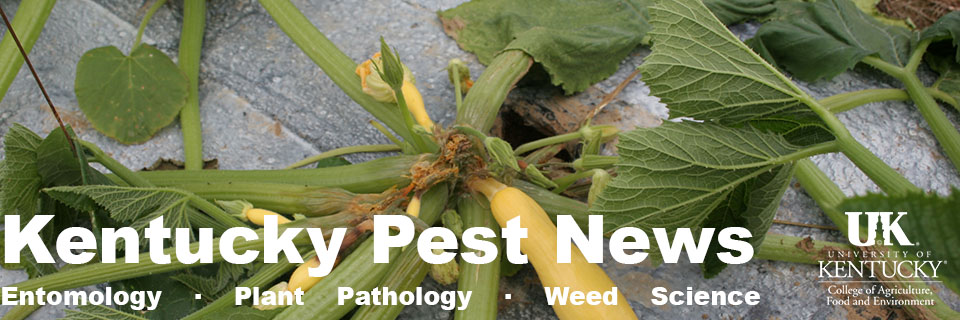Tomato and potato producers in eastern and central Kentucky should be advised of recent confirmations of late blight in western North Carolina and eastern Tennessee. Late blight is caused by Phytophthora infestans, an oomycete pathogen, and usually advances from the…
Monthly Archives: September 2015
Asian Woolly Hackberry Aphids: Insect Snow Flakes
Asian woolly hackberry aphids are distinctive insects. A covering of thin bluish-white waxy filaments causes these small sap-feeding insects to standout on foliage (Figure 1). They can look like large wet snowflakes, especially as they drift through the air (Figure…
Plant Disease Diagnostic Lab Highlights
The following plant disease highlights from the University of Kentucky Plant Disease Diagnostic Laboratories represent recent sample submissions from field crops, fruit, vegetables, and ornamentals. Recent agronomic samples have included frogeye leaf spot on soybean; black shank, frogeye, and angular…
New Corn Disease Found in Bordering States
Tar spot of corn, a foliar disease caused by the fungus Phyllachora maydis, recently was found in the United States for the first time. The disease was confirmed in Indiana and Illinois. Pictures of the disease and more information about…
Featured Publication
Midwest Blueberry Production Guide (ID-210) Blueberries are one of Kentucky’s emerging small fruit crops, with cultivated blueberry production acreage increasing 73% from 2007 to 2012. As acreage increases, so does the need for growers to follow sound cultural practices. The…
2015 Insect Trap Counts
Trap counts for major insect pests are provided by the Kentucky IPM Program. Traps are located at the UK Research and Education Center in western Kentucky and the UK Spindletop Farm in Lexington. Below are trap counts for the current…
Featured Publication
Winter Decline Syndrome of Canola (PPFS-AG-R-01) Interest in producing canola in Kentucky has greatly increased in recent years. During the last canola “boom” in Kentucky during the late 1980s, a serious concern was the rapid decline of stands during late…
Plant Disease Diagnostic Lab Highlights
The following plant disease highlights from the University of Kentucky Plant Disease Diagnostic Laboratories represent recent sample submissions from field crops, fruit, vegetables, and ornamentals. Recent agronomic samples have included anthracnose, sudden death syndrome, soybean cyst nematode, and frogeye leaf…
2015 Insect Trap Counts
Trap counts for major insect pests are provided by the Kentucky IPM Program. Traps are located at the UK Research and Education Center in western Kentucky and the UK Spindletop Farm in Lexington. Below are trap counts for the current…
Seeing Orange in Your Corn?
The pathogen of southern rust of corn (Puccinia polysora) has infected a lot of corn fields in Kentucky within the last month. Orange pustules (Figure 1) covering affected leaves are common, and can make your shirt turn orange when walking…
Armyworm Moth Captures are Abnormally Large
Recent moth flight of armyworm (AW), Mythimna unipuncta (Figure 1), in western Kentucky has been much larger than is normal for this time of year. It is not terribly unusual to see problems with this insect on pasture and forage…
Stem Breaks from Alfalfa Hopper
The three-cornered alfalfa hopper is a green, wedge-shaped, sap-feeding insect (Figure 1) that causes distinct physical injury. Adults and nymphs girdle stems, lateral branches, or petioles as they feed on legumes and a variety of other plants. Symptoms include yellowing…
Watch for White Grubs in Irrigated Turfgrass
Eggs of our common white grub species (masked chafers and Japanese beetles) need moisture to stimulate hatch. Frequent irrigation in June and July may attract egg-laying female beetles to turf, especially if surrounding areas are dry. High soil moisture also…
Stinging Caterpillars
Stinging caterpillars are common in late summer and early fall. Skin contact with them may produce a range of symptoms: Numbness Reddening and inflammation Intense burning Severe pain Pustules and other lesions. Pain, occasionally accompanied by nausea and headaches, may…
Palmer Amaranth and Waterhemp Continue to Expand Across Kentucky
Glyphosate-resistant Palmer amaranth (Amaranthus palmeri) and waterhemp (Amaranthus tuberculatus) continue to spread across Kentucky. Initially these pigweed species were thought to be present primarily in the west end of the state (Purchase Area and along the lower Ohio River Region),…
